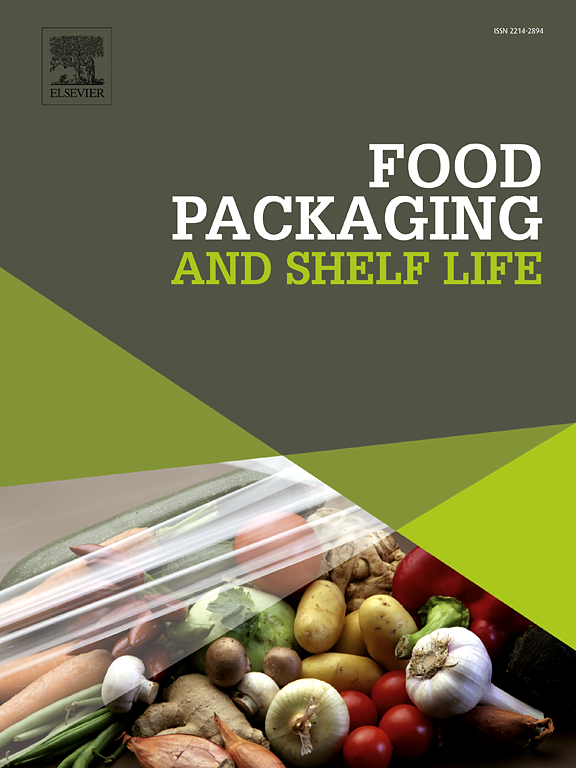肉桂醛和单宁酸纳米乳剂对冷藏过程中肉类品质和蛋白质氧化的影响
IF 8.5
1区 农林科学
Q1 FOOD SCIENCE & TECHNOLOGY
引用次数: 0
摘要
研究了壳聚糖包覆肉桂醛(CIN)和单宁酸(TA)纳米乳液对冷藏猪肉品质和蛋白质氧化的影响。肉桂醛-单宁酸(CIN-TA)纳米乳液在4 °C温度下,在12天内无相分离,液滴大小波动最小,表明其具有较强的肉类保鲜适用性。壳聚糖/肉桂醛单宁酸纳米乳液(CS/CIN-TAs)的应用通过减少肉的质构变化、液滴损失、离心损失和肌原纤维降解,有效地保存了肉的质地。电子鼻分析表明,该涂层在整个储存过程中保持了猪肉原有的风味特征。该涂层显著抑制脂质氧化,CS/CIN-TA2组在储存后的过氧化值比对照组降低了23.17 %。CS/CIN-TA2中羰基含量(0.84 nmol/mg)显著降低,为对照组的66.15 %,显著降低了蛋白质氧化。此外,涂层降低了二聚酪氨酸含量,延缓了表面疏水性的升高,保持了硫醇含量(173.29 μmol/g蛋白)和ca2 + - atp酶活性,从而保持了肌原纤维蛋白结构的完整性。这些结果表明CS/CIN-TA涂层作为一种有效的抗氧化屏障,从而延缓脂质和蛋白质的氧化过程。因此,冰鲜猪肉的质量和保质期得到了极大的提高,证明了该涂层在改善鲜肉产品储存稳定性方面的潜力。本文章由计算机程序翻译,如有差异,请以英文原文为准。
Effect of cinnamaldehyde and tannic acid nano-emulsions on meat quality and protein oxidation during cold storage
The study investigated the effects of a chitosan coating (CS) loaded with cinnamaldehyde (CIN) and tannic acid (TA) nano-emulsions on the quality and protein oxidation of chilled pork during cold storage. Cinnamaldehyde-Tannic Acid (CIN-TA) nano-emulsions displayed minimal droplet size fluctuations without phase separation over 12 days at 4 °C, indicating their strong applicability for meat preservation. The application of chitosan/cinnamaldehyde tannic acid nano-emulsions (CS/CIN-TAs) effectively preserved meat texture by reducing textural changes, droplet loss, centrifugal loss, and myofibrils degradation. Electronic nose analysis demonstrated that the coating maintained the pork’s original flavor profile throughout storage. The coating significantly inhibited lipid oxidation, with the CS/CIN-TA2 group exhibiting a 23.17 % reduction in peroxide value compared to the control group after storage. Moreover, protein oxidation was reduced significantly, as evidenced by the substantially lower carbonyl content (0.84 nmol/mg) in the CS/CIN-TA2, which was 66.15 % of the carbonyl content in the control group. Additionally, the coating decreased dimeric tyrosine content, delayed the rise in surface hydrophobicity, and maintained thiol content (173.29 μmol/g protein) and Ca²⁺-ATPase activity, thereby preserving myofibrillar protein structural integrity. These findings indicate that the CS/CIN-TA coating functions as an efficacious antioxidant barrier, thereby retarding lipid and protein oxidation processes. Consequently, the quality and shelf life of chilled pork were substantially enhanced, demonstrating the coating’s potential for improving the storage stability of fresh meat products.
求助全文
通过发布文献求助,成功后即可免费获取论文全文。
去求助
来源期刊

Food Packaging and Shelf Life
Agricultural and Biological Sciences-Food Science
CiteScore
14.00
自引率
8.80%
发文量
214
审稿时长
70 days
期刊介绍:
Food packaging is crucial for preserving food integrity throughout the distribution chain. It safeguards against contamination by physical, chemical, and biological agents, ensuring the safety and quality of processed foods. The evolution of novel food packaging, including modified atmosphere and active packaging, has extended shelf life, enhancing convenience for consumers. Shelf life, the duration a perishable item remains suitable for sale, use, or consumption, is intricately linked with food packaging, emphasizing its role in maintaining product quality and safety.
 求助内容:
求助内容: 应助结果提醒方式:
应助结果提醒方式:


